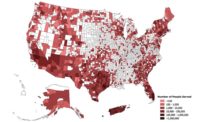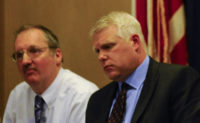We cannot ignore the evidence of a growing crisis in our increasingly inadequate and aging water infrastructure. Lead contamination in Flint, Mich., frozen pipes bursting in the Texas ice storms, and funding that's failing to keep up with need nationwide have all been in the headlines recently. The good news is that we know how to chart a path forward. The solution to our water crisis requires continued innovation from the private sector, policy action from the public sector, and collaboration between all.
We at Autodesk are committed to supporting this better path forward. The opportunity exists to fundamentally reshape our water systems by improving the execution of projects from planning through to operations and maintenance. This vision is the driving force behind Autodesk’s recent acquisition of Innovyze, a global leader in water infrastructure software development. The acquisition brings together Autodesk’s design, engineering, and construction software with Innovyze’s modeling, simulation, asset management and predictive analytics solutions. Together, these create an end-to-end water infrastructure solution to enable more cost-effective, resilient, and sustainably designed water networks.
The water crisis faced by Toledo, Ohio, residents in August 2014 illustrates the challenges many municipal water systems face — and importantly, the opportunities — in water infrastructure. A toxic algae bloom in Lake Erie caused a "do not drink" advisory, creating the threat of stomach illness, respiratory issues, and even liver failure. Then-Gov.John Kasich declared a state of emergency, the National Guard and Red Cross set up water distribution centers, and the system’s half-million residents were without tap water for three days.
Built in the 1940s and '50s, Toledo’s water treatment facilities were outdated, lacked capacity, and unprepared to respond to algae bloom events, which are increasing. Another one appeared in the Maumee River, which runs through Toledo, in 2017. Toledo’s situation was hardly an outlier. The American Society of Civil Engineers (ASCE) 2021 Infrastructure Report Card gives the nation’s drinking water systems a C-. It looks even worse for wastewater with a D+ and stormwater with a D. These problems can lead to major disruptions such as Toledo's 2014 drinking water crisis or take the form of a slow drip — aging pipes that quietly leak and waste precious water until one day they burst. ASCE estimates a water main break every two minutes in the U.S. and 6 billion gallons of water are lost every day.
The nation’s web of pipes that run underground to catch, process, and funnel our water was largely built in the early 20th century. While the infrastructure has deteriorated without sufficient public investment to fix it, technology has advanced by leaps and bounds to help address the problems and stretch already limited public funding.
Digitization Brings Efficiency and Resilience to Water Infrastructure
Toledo’s approach to solving its water treatment problem after 2014 is a study in civil infrastructure improvements done the new way, the approach that should be expected and customary. The plan called for expanding capacity with two new basins while upgrading the city's six existing basins and keeping its water treatment facility operational during construction. From the start, the project team including design and engineering firm Arcadis and its contractors partners deployed cloud collaboration software used by everyone on the project, bringing together a range of disciplines and sub-consultants despite being spread out from Ohio to Florida. The team also embraced reality capture and augmented reality (AR) to create precise representations of site conditions and enable collaborators to virtually visit the site.
The fully digitized approach was a success. The team met state-mandated deadlines, saving more than 1,000 hours in the design process. When COVID-19 hit, everyone was ready to adapt. With only finishing work left on the new basins, cloud collaboration software enabled crews to continue visiting the jobsite virtually, supported safe workplaces, and kept the project moving forward.
The digitization of traditionally analog workflows and processes is essential to catch up with our infrastructure needs, saving time and money, both of which are in short supply. ASCE estimates the annual drinking water and wastewater investment gap will grow to $434 billion (about $1,300 per person in the U.S.) by 2029.
Public Sector Needed to Push the Industry Forward
Technology, alone, cannot solve our nation's water system problems. The evolution of the design and construction industries requires collaboration between the private sector and the public sector at all levels of government. While the private sector continues to provide opportunities with technology to stretch limited natural and financial resources, the federal government should consider incentives to support the digitization effort for the advancement of technology in civil infrastructure. Earlier this year, Autodesk CEO Andrew Anagnost offered a series of policy suggestions to the Biden-Harris Administration and Congress to spur economic and job growth, improve sustainability and to speed up the pace of transformation.
The residents of Toledo learned about our collective failure to act on infrastructure the hard way. Without action, we will see history repeat itself in communities large and small across the nation. Climate change is leading to more severe weather, where flooding, ice, drought, and toxins are all increasingly greater threats to a most basic need. Water is life, so intertwined in our daily existence that it is easy to take for granted, but it is time to heed the warning signs. The tools to transform the water industry are available today, and the time to act is now.
Theo Agelopoulos is senior director of Autodesk’s infrastructure business. He played a leading role in the acquisition of Innovyze, and a key role in Autodesk’s business model transformation – specifically in its architecture, engineering and construction business.





Post a comment to this article
Report Abusive Comment